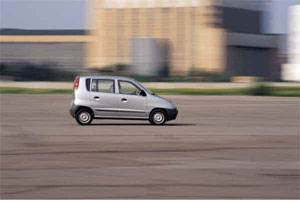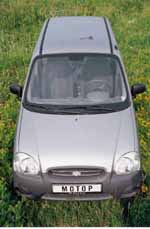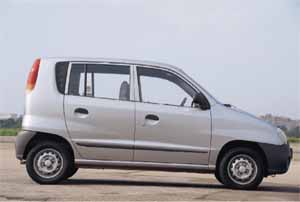Hyundai Atos 2003 test drive - 2005 hatchback
Korean diploma
 The headlines of publications dedicated to this machine - those who are known to us - all as one beat the musketeer theme. Well, atos so atos ... But the car appeared before us alive, and we began to wipe our eyes. On the back door - albeit stylized, but completely clear metallized letters ... and not atos at all, but atoz! The first thought - glued the not the same side. But no - the whole word is distinguished entirely. Maybe some special version?
The headlines of publications dedicated to this machine - those who are known to us - all as one beat the musketeer theme. Well, atos so atos ... But the car appeared before us alive, and we began to wipe our eyes. On the back door - albeit stylized, but completely clear metallized letters ... and not atos at all, but atoz! The first thought - glued the not the same side. But no - the whole word is distinguished entirely. Maybe some special version? Everything turned out to be easier. Even the Koreans themselves call this car so and that. On the official website Hyundai - ATOS. In the photo there - ATOZ. And in the description of the machine, the name is completely double - ATOS (ATOZ). The point, most likely, is that the Latin letters are as unusual for Koreans as their hieroglyphs are for us. Or Cyrillic - for the British. After all, vague Albionians write our letter and as Latin N, when, not knowing the language, they copy the Russian text - and vice versa ... So in Korea - some letters, apparently, made the stamp in the wrong direction. It’s good that ATAS did not work out ...
 At first glance, a hundred percent citizen is recognized in the car. The length of the car is less than 3.5 m, the width is less than one and a half, the overhang of the body is minimal ... All to the fact that in deaf traffic jams ATOZ with its dimensions should feel like fish in water. The large height of the machine (1600 mm), and therefore the salon (1290 mm), leave no doubt that the residential volume will arrange not only stooped ones. The rows of seats (due to high legs, they would be more appropriate to call chairs) are located an amphitheater - a pillow of the rear sofa of centimeters ten higher than the front -line pillows. With this layout, the landing of the driver and passengers is more vertical than in an ordinary car - this allows you to play a dozen or two centimeters of the interior and create an acceptable level of comfort for four tall people.
At first glance, a hundred percent citizen is recognized in the car. The length of the car is less than 3.5 m, the width is less than one and a half, the overhang of the body is minimal ... All to the fact that in deaf traffic jams ATOZ with its dimensions should feel like fish in water. The large height of the machine (1600 mm), and therefore the salon (1290 mm), leave no doubt that the residential volume will arrange not only stooped ones. The rows of seats (due to high legs, they would be more appropriate to call chairs) are located an amphitheater - a pillow of the rear sofa of centimeters ten higher than the front -line pillows. With this layout, the landing of the driver and passengers is more vertical than in an ordinary car - this allows you to play a dozen or two centimeters of the interior and create an acceptable level of comfort for four tall people.  The result of further efforts of layouts is flat internal door panels and a compact torpedo. The latter is essentially a regiment with three niches (one of them is exactly under a cigarette pack). The glove box moved under the right front chair and is a sliding tray, similar to a large ashtray. The interior is full of Korean color: cheap plastic, seams and traces of casting are visible in some places ... All this is quite consistent with the price category of the car.
The result of further efforts of layouts is flat internal door panels and a compact torpedo. The latter is essentially a regiment with three niches (one of them is exactly under a cigarette pack). The glove box moved under the right front chair and is a sliding tray, similar to a large ashtray. The interior is full of Korean color: cheap plastic, seams and traces of casting are visible in some places ... All this is quite consistent with the price category of the car. Seats - with a comfortable profile and very mean adjustments back and forth. With the front chair pushed to the stop, and to the stop forward - the rear passenger will be content with small: it seems that it is not crowded, but not spacious. Consolation can be a large air gap between the tops and the ceiling. The back back can only be folded entirely, so there are no options for transporting more than one passenger and at the same time a washing machine.
 Devices. Three round scales are collected under a visor - in shape and size, all this resembles a dash combination on a scooter. Information is read without problems. Only the most necessary data are displayed - speed, temperature, fuel supply. And even then to say: who travels during the peak hours on devices, especially - by tachometer?! Much more important is visibility. Everything is in openwork: from the driver’s place it is very clearly visible what is happening in the immediate vicinity of the front bumper, on the sides and even behind (despite the high lower line of the rear window). A review on external mirrors - massive burdocks - also does not leave dead zones.
Devices. Three round scales are collected under a visor - in shape and size, all this resembles a dash combination on a scooter. Information is read without problems. Only the most necessary data are displayed - speed, temperature, fuel supply. And even then to say: who travels during the peak hours on devices, especially - by tachometer?! Much more important is visibility. Everything is in openwork: from the driver’s place it is very clearly visible what is happening in the immediate vicinity of the front bumper, on the sides and even behind (despite the high lower line of the rear window). A review on external mirrors - massive burdocks - also does not leave dead zones.  ATOZ body proportions determine its unusual appearance. Special signs: sloping forehead (huge windshield), straight posture (a wide vertical rear stand with a block of lamps on it), large eyes (headlights entering the hood and wings). In the appearance of ATOZ there is something from the concept car Mercedes-Benz Vision A93 (the last prototype A-class) ...
ATOZ body proportions determine its unusual appearance. Special signs: sloping forehead (huge windshield), straight posture (a wide vertical rear stand with a block of lamps on it), large eyes (headlights entering the hood and wings). In the appearance of ATOZ there is something from the concept car Mercedes-Benz Vision A93 (the last prototype A-class) ... Hyundai Atoz - a full -fledged (in our national sense) car. If only because the engine is not three, but four cylinders and wheels are not 12, but 13-inch.
 The liter motor has a typical configuration for Hyundai - 3 valves per cylinder under one camshaft. At the exit - 59 hp Given that the average city car is constantly lucky with one driver and only 0.3 passengers, then in practice, the total mass of ATOZ will rarely exceed a ton. And in order to confidently move, six dozen horses are more than enough for him.
The liter motor has a typical configuration for Hyundai - 3 valves per cylinder under one camshaft. At the exit - 59 hp Given that the average city car is constantly lucky with one driver and only 0.3 passengers, then in practice, the total mass of ATOZ will rarely exceed a ton. And in order to confidently move, six dozen horses are more than enough for him. It is worth paying attention to the feature of the ATOZ transmission (in addition to the usual 5-speed manual box, the car can be equipped with a mechanics with automatic clutch or 3-speed automatic): the gear ratio of the main pair is 4.53. Such a short main gear limits the maximum speed, but allows you to inform the drive wheels with a greater traction force - which is very important in the conditions of the metropolis. In the first gear, you can slowly, without slipping, drag in a traffic jam. On the second, ATOZ touches the hill and accelerates to 60 km/h. The third begins to work already at 30 km/h, and if the road allows you to economically roll at low engine speeds, then after 40 you can turn on the fourth.
 Starting at ATOZ from a traffic light, you can easily furnish more serious cars - the motor is spinning very lively, and the lever moves allow you to quickly sort through the gears. No tension is felt. Some Jeep was aiming for overtaking for a long time, but our car, without reducing speed, laid the turns of inaccessible to it, and the big and wide every time was forced to let go forward either BMW or the trolley. ATOZ slipped between them, like a male through a large network.
Starting at ATOZ from a traffic light, you can easily furnish more serious cars - the motor is spinning very lively, and the lever moves allow you to quickly sort through the gears. No tension is felt. Some Jeep was aiming for overtaking for a long time, but our car, without reducing speed, laid the turns of inaccessible to it, and the big and wide every time was forced to let go forward either BMW or the trolley. ATOZ slipped between them, like a male through a large network. Dynamics. Acceleration to 80 km/h occurs as easily and imperceptibly as, say, on Hyundai Accent with a one and a half liter engine. But further acceleration is decaying. It is felt how ATOZ literally crashes into a raising air flow with its forehead. On a hundred, the third gear rested - come on the fourth. After a few seconds (driving it seems that this is an eternity) The speedometer shooter reluctantly exceeds the three -digit mark. The pedal has long been in the floor, and the device seems to be mocking, slowly counting 104 ... 105 ... 106 ... Only after 120 does a smooth, but confident acceleration begins. The maximum speed that ATOZ can develop is 150 km/h. But in order to get it up to at least up to 140 along the speedometer, we barely had enough runway of the airfield (taking into account the place left for inhibition).
 In relation to Hyundai Atoz, this dynamics cannot be called a failure. In the first three programs, you can go on the moment (therefore - with the possibility of sprint acceleration) and, as a result, accelerate to 100 km/h. (Not every car will be able to accelerate on the segment between the two traffic lights, and even during the peak hours - except for some sports car ... not to mention the fact that we do not have settlements where it is allowed to drive at such a speed. ) So Hyundai AtoZ realizes all its sprint capabilities at the place of constant deployment - namely, in the conditions of a megalopolis and a dense automobile flow. Here it is helped out by excellent maneuverability and a very light steering wheel.
In relation to Hyundai Atoz, this dynamics cannot be called a failure. In the first three programs, you can go on the moment (therefore - with the possibility of sprint acceleration) and, as a result, accelerate to 100 km/h. (Not every car will be able to accelerate on the segment between the two traffic lights, and even during the peak hours - except for some sports car ... not to mention the fact that we do not have settlements where it is allowed to drive at such a speed. ) So Hyundai AtoZ realizes all its sprint capabilities at the place of constant deployment - namely, in the conditions of a megalopolis and a dense automobile flow. Here it is helped out by excellent maneuverability and a very light steering wheel.  The maximum speed can only be achieved at the fourth - highway - transmission, which begins to work with 50 km/h. So, having left for Hyundai Atoz on a good highway, there is no reason to sit in the extreme right row. The highest, fifth, transfer (as they say - economical) is designed to maintain maximum speed. Acceleration on it occurs with a very lazy progression, and even then-within 125-130 km/h. Further, all the thrust is spent on overcoming air resistance and tire friction.
The maximum speed can only be achieved at the fourth - highway - transmission, which begins to work with 50 km/h. So, having left for Hyundai Atoz on a good highway, there is no reason to sit in the extreme right row. The highest, fifth, transfer (as they say - economical) is designed to maintain maximum speed. Acceleration on it occurs with a very lazy progression, and even then-within 125-130 km/h. Further, all the thrust is spent on overcoming air resistance and tire friction.  The brakes are beyond praise - a confident slowdown without wheels lock (the ABS is not included in the standard equipment).
The brakes are beyond praise - a confident slowdown without wheels lock (the ABS is not included in the standard equipment). It should be noted that the car is largely affected by external factors, such as the wind and the irregularities of the road. With its very modest aerodynamic characteristics and high sailing, Hyundai Atoz is prone to Ryskanya - you just have to grab the side wind, as the car pulls to the side. The cruising move is accompanied by a scan and upbringing of the body. Soft long -speed suspension, well -core with the city
 off -road, at high speed is no longer able to maintain the perfect terminal stability of the car. But do not forget that the motorway for ATOZ is an atypical field of activity, and therefore leave all hope that on the highway it will be as irresistible as in a hopeless bang.
off -road, at high speed is no longer able to maintain the perfect terminal stability of the car. But do not forget that the motorway for ATOZ is an atypical field of activity, and therefore leave all hope that on the highway it will be as irresistible as in a hopeless bang. However, in the city - you will sit an hour or two in the cork, so you will want to go to another car: more, more amicable ... But this is not the fault of ATOZ, but the trouble of the modern concept of a city car.
Yuri Tikhvin
Source: Motor magazine [No. 10/1998]

